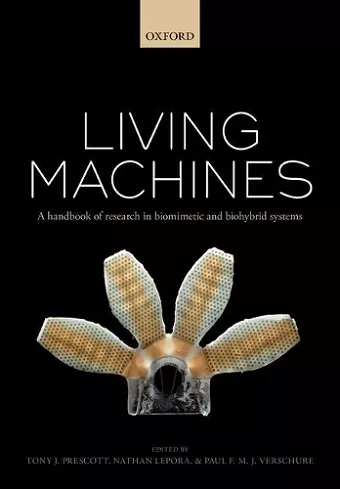Living machines
A handbook of research in biomimetics and biohybrid systems
Tony J Prescott editor Paul FMJ Verschure editor Nathan Lepora editor
Format:Hardback
Publisher:Oxford University Press
Published:26th Apr '18
Currently unavailable, and unfortunately no date known when it will be back

Winner of the BMA Basic & Clinical Sciences Book Award 2019
Contemporary research in the field of robotics attempts to harness the versatility and sustainability of living organisms with the hope of rendering a renewable, adaptable, and robust class of technology that can facilitate self-repairing, social, and moral--even conscious--machines. This landmark volume surveys this flourishing area of research.Contemporary research in science and engineering is seeking to harness the versatility and sustainability of living organisms. By exploiting natural principles, researchers hope to create new kinds of technology that are self-repairing, adaptable, and robust, and to invent a new class of machines that are perceptive, social, emotional, perhaps even conscious. This is the realm of the 'living machine'. Living machines can be divided into two types: biomimetic systems, that harness the principles discovered in nature and embody them in new artifacts, and biohybrid systems in which biological entities are coupled with synthetic ones. Living Machines: A handbook of research in biomimetic and biohybrid systems surveys this flourishing area of research, capturing the current state of play and pointing to the opportunities ahead. Promising areas in biomimetics include self-organization, biologically inspired active materials, self-assembly and self-repair, learning, memory, control architectures and self-regulation, locomotion in air, on land or in water, perception, cognition, control, and communication. Drawing on these advances the potential of biomimetics is revealed in devices that can harvest energy, grow or reproduce, and in animal-like robots that range from synthetic slime molds, to artificial fish, to humanoids. Biohybrid systems is a relatively new field, with exciting and largely unknown potential, but one that is likely to shape the future of humanity. This book surveys progress towards new kinds of biohybrid such as robots that merge electronic neurons with biological tissue, micro-scale machines made from living cells, prosthetic limbs with a sense of touch, and brain-machine interfaces that allow robotic devices to be controlled by human thought. The handbook concludes by exploring some of the impacts that living machine technologies could have on both society and the individual, exploring questions about how we will see and understand ourselves in a world in which the line between the natural and the artificial is increasingly blurred. With contributions from leading researchers from science, engineering, and the humanities, this handbook will be of broad interest to undergraduate and postgraduate students. Researchers...
Living machines is a fascinating overview of the current state of play across many and varied fields engaging in research about biometric and biohybrid systems and robotics ... It is beautifully produced. * BMA reviewing panel, BMA Medical Book Awards 2019 *
The book's strength is its weaving together robotics and biology, with numbers used to compare the accuracy and capability of these systems... [I would] recommend this ambitious and useful work to anyone who is looking to be inspired by the future of biological robotics. * David L. Hu, Mechanical Engineering & Biology, Georgia Institute of Technology, Atlanta, Georgia *
- Winner of Winner of the BMA Basic and Clinical Sciences Book Award 2019.
ISBN: 9780199674923
Dimensions: 253mm x 178mm x 35mm
Weight: 1348g
656 pages